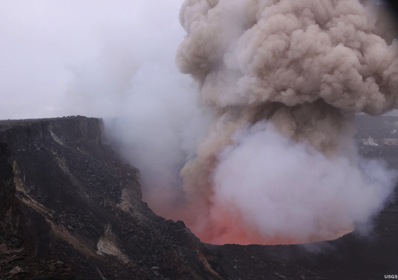2013 News & Events
Recent trends in stratospheric aerosol explained by volcanic sources rather than anthropogenic emissions
1 March 2013
modified from the story by CIRES Communications

In the search for clues as to why Earth did not warm as much as scientists expected between 2000 and 2010, researchers have discovered that dozens of volcanoes spewing sulfur dioxide have tempered the warming by causing an increase in stratospheric particles.
Small amounts of sulfur dioxide emissions from Earth's surface eventually rise 12 to 20 miles into the stratospheric aerosol layer of the atmosphere, where chemical reactions create sulfuric acid and water particles that reflect sunlight back to space, cooling the planet. The findings essentially shift the focus away from Asia as being the source of the stratospheric aerosol increase. In southeast Asia, industrial sulfur dioxide emissions have increased by about 60 percent from 2000 to 2010 through coal burning, said lead author Ryan Neely, a CIRES scientist working with CSD and GMD.
Neely said previous observations suggest that increases in stratospheric aerosols since 2000 have counterbalanced as much as 25 percent of the warming scientists attribute to human greenhouse gas emissions. "This new study indicates it is emissions from small to moderate volcanoes that have been slowing the warming of the planet," said Neely.
The paper "Recent anthropogenic increases in SO2 from Asia have minimal impact on stratospheric aerosol" was published online in Geophysical Research Letters, a publication of the American Geophysical Union. Co-authors include Professors Brian Toon and Jeffrey Thayer from CU Boulder; Susan Solomon, a former NOAA scientist now at the Massachusetts Institute of Technology; Jean Paul Vernier from NASA's Langley Research Center in Hampton, VA; Christine Alvarez, Karen Rosenlof and John Daniel from NOAA; and Jason English, Michael Mills and Charles Bardeen from the National Center for Atmospheric Research in Boulder.
The new study relies on long-term measurements of changes in the stratospheric aerosol layer's "optical depth," which is a measure of transparency, said Neely. Since 2000, the optical depth in the stratospheric aerosol layer has increased by about 4 to 7 percent, meaning it is slightly more opaque now than in previous years.
"The biggest implication here is that scientists need to pay more attention to small and moderate volcanic eruptions when trying to understand changes in Earth's climate," said Toon. Overall these eruptions are not going to counter the human caused greenhouse warming, he said. "Emissions of volcanic gases go up and down, helping to cool or heat the planet, while greenhouse gas emissions from human activity just continue to go up."
The key to the new results was the combined use of two sophisticated computer models, including the Whole Atmosphere Community Climate Model, or WACCM, Version 3, developed by NCAR and which is widely used around the world by scientists to study the atmosphere. The team coupled WACCM with a second model, the Community Aerosol and Radiation Model for Atmosphere (CARMA), which allows researchers to calculate properties of specific aerosols and which has been under development by a team led by Toon for the past several decades.
Neely said the team used the Janus supercomputer on (the CU) campus to conduct seven computer "runs," each simulating 10 years of atmospheric activity tied to both coal-burning activities in Asia and to emissions by volcanoes around the world. Each run took about a week of computer time using 192 processors, allowing the team to separate the contribution of SO2 pollution in Asia from that produced by moderate, global volcanic eruptions. The project would have taken a single computer processor roughly 25 years to complete, said Neely.
The scientists said 10-year climate data sets like the one gathered for the new study are not long enough to assess reasons for long term climate changes. "This paper addresses a question of immediate relevance to our understanding of the human impact on climate," said Neely. "It should interest those examining the sources of decadal climate variability, the global impact of local pollution and the role of volcanoes."
While small and moderate volcanoes mask some of the human-caused warming of the planet, larger volcanoes can have a much bigger effect, said Toon. When Mount Pinatubo in the Philippines erupted in 1991, it emitted millions of tons of sulfur dioxide into the atmosphere that cooled the Earth slightly for the next several years.
The research for the new study was funded in part through a NOAA ESRL / CIRES Graduate Fellowship to Neely. The National Science Foundation and NASA also provided funding for the research project. The Janus supercomputer is supported by NSF and CU Boulder and is a joint effort of CU Boulder, CU Denver and NCAR.
R. R. Neely III, O. B. Toon, S. Solomon, J. P. Vernier, C. Alvarez, J. M. English, K. H. Rosenlof, M. J. Mills, C. G. Bardeen, J. S. Daniel, J. P. Thayer, Recent anthropogenic increases in SO2 from Asia have minimal impact on stratospheric aerosol Geophysical Research Letters, doi:10.1002/grl.50263, 2013.
Abstract
Observations suggest that the optical depth of the stratospheric aerosol layer between 20 and 30 km has increased 4-10% per year since 2000, which is significant for Earth's climate. Contributions to this increase both from moderate volcanic eruptions and from enhanced coal burning in Asia have been suggested. Current observations are insufficient to attribute the contribution of the different sources. Here we use a global climate model coupled to an aerosol microphysical model to partition the contribution of each. We employ model runs that include the increases in anthropogenic sulfur dioxide (SO2) over Asia and the moderate volcanic explosive injections of SO2 observed from 2000 to 2010. Comparison of the model results to observations reveals that moderate volcanic eruptions, rather than anthropogenic influences, are the primary source of the observed increases in stratospheric aerosol.